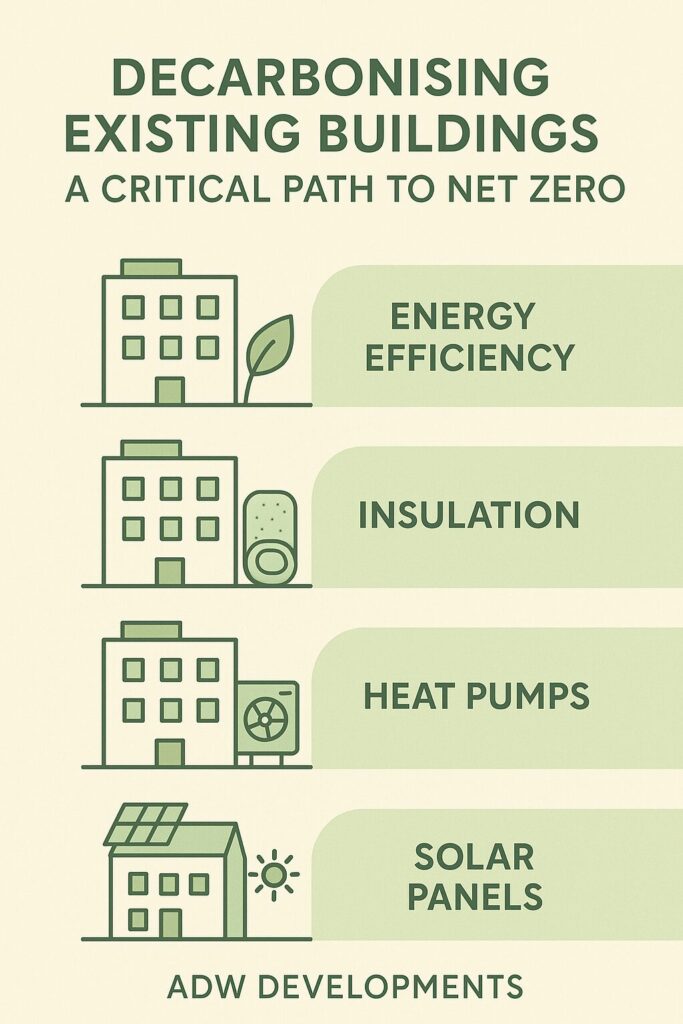Achieving net zero by 2050 puts the spotlight firmly on our existing buildings. While new, energy-efficient developments get plenty of attention, the majority of the building stock that will exist in 2050 is already here. This presents a significant challenge, and an equally significant opportunity to decarbonise and future-proof our built environment.
Success requires more than cutting day-to-day energy use. It calls for a whole-life perspective that considers both operational carbon and the embodied carbon in retrofit materials and processes.
In today’s Knowledge Share, we explore how retrofitting can reduce whole life carbon, the key challenges involved, and the strategies that can turn ageing buildings into climate assets. By applying integrated planning and innovative solutions, we can unlock significant carbon savings and accelerate the transition to a resilient, low-carbon future.

The Decarbonisation Imperative: Why Existing Buildings Matter Most
Existing buildings account for a significant share of global carbon emissions. Their operational energy use for heating, cooling, lighting and ventilation contributes heavily to greenhouse gas output. At the same time, the embodied carbon already locked into their structures underlines the importance of extending their lifespan. Demolition and replacement would only add to emissions through additional embodied carbon. Consequently, decarbonising existing buildings is not a choice but a fundamental requirement for achieving national and international climate targets.
The Scale of the Challenge
Retrofitting existing buildings presents a set of challenges distinct from new construction.
- Diversity of building stock: Existing buildings differ greatly in age, construction method, materials and energy performance. A uniform approach is ineffective; each requires a tailored solution.
- Technical complexity: Integrating modern, energy-efficient systems into older structures can be technically demanding. Careful planning is essential to avoid service disruption or structural compromise.
- Occupancy and disruption: Many retrofits must take place while buildings remain in use, requiring phased delivery and careful communication with occupants.
- Cost and funding: Deep retrofits often require significant upfront investment. While long-term savings are substantial, securing finance can be a barrier for many owners.
- Preservation and heritage: For listed or heritage buildings, energy upgrades must be carefully balanced with preservation, ensuring historical and architectural integrity is not compromised.
- Data gaps: Reliable information on energy performance and material composition is frequently limited, making it harder to design effective retrofits and measure carbon savings.
Despite these obstacles, the sheer scale of existing building stock means its decarbonisation represents the single greatest opportunity for carbon reduction in the built environment. Addressing these complexities with innovative strategies is therefore crucial.
Key Strategies for Whole Life Carbon Reduction in Retrofit Projects
Decarbonising existing buildings demands a holistic approach, addressing both operational and embodied carbon. The following strategies are particularly critical.
1. Prioritising Deep Energy Retrofits
Deep retrofits seek to cut operational energy use significantly often by 50% or more. This typically involves a combination of measures:
- Building envelope improvements: Upgrading insulation, roofs, floors and glazing, alongside improving airtightness, can substantially reduce heat loss and gain, lowering demand for heating and cooling.
- Efficient HVAC systems: Replacing outdated systems with high-efficiency alternatives such as heat pumps can cut energy use dramatically. Smart controls and demand-side management further optimise performance.
- Renewable energy integration: Installing on-site generation such as solar PV or connecting to renewable district heating and cooling networks helps offset remaining demand, moving buildings towards net zero operational carbon.
- Efficient lighting and appliances: Switching to LED lighting and high-performance appliances reduces electricity use, contributing to overall savings.
These measures directly address operational carbon, which often forms the largest portion of a building’s whole life footprint.
2. Minimising Embodied Carbon in Retrofit Materials
While retrofits reduce operational carbon, they introduce embodied carbon through new materials. Minimising this impact is essential.
- Material selection: Choosing low-carbon options such as recycled-content insulation, timber-based products or materials with lower manufacturing emissions reduces the carbon burden of retrofits.
- Reuse and salvage: Retaining existing components and reusing salvaged materials, whether on-site or elsewhere, cuts demand for new products.
- Local sourcing: Procuring materials locally reduces transport-related emissions.
- Efficient construction practices: Applying lean methods, minimising waste and optimising logistics all contribute to lower embodied carbon.
3. Extending Building Lifespan and Adaptability
One of the most effective strategies for reducing whole life carbon is extending the useful life of buildings. Retrofits should therefore focus on durability and adaptability.
- Designing for durability: Using robust, long-lasting materials reduces the need for frequent replacements, limiting embodied emissions from maintenance and renovation.
- Enhancing adaptability: Designing spaces that can be easily reconfigured for future uses minimises the risk of demolition or major interventions, preserving the carbon already invested in the structure.
In this way, retrofits not only deliver immediate benefits but also secure long-term carbon savings.
The Role of Digital Tools and Data in Decarbonisation
Successful retrofits increasingly rely on accurate data and advanced digital tools. These technologies support better decision-making, optimise retrofit strategies and allow ongoing performance monitoring.
- Building Information Modelling (BIM): Scan-to-BIM methods create precise 3D models of existing buildings, capturing both physical and functional detail. This forms a vital basis for analysing systems, planning retrofits and calculating embodied carbon.
- Digital twins: Linking BIM to real-time sensor data creates a dynamic digital twin, enabling continuous monitoring, scenario testing and optimisation.
- Life Cycle Assessment (LCA) software: Specialised tools help quantify whole life carbon impacts of different materials and approaches, supporting evidence-based choices.
- Energy modelling and simulation: Advanced modelling predicts performance under varied conditions, informing the design of energy-efficient systems.
- Data analytics and AI: Analysing usage patterns, predicting maintenance needs and improving operations all contribute to carbon reductions.
These tools provide the foresight and intelligence needed to ensure retrofit investments deliver maximum impact.
Policy and Financial Mechanisms: Enabling the Transition
While technology is critical, supportive policy and finance are equally essential to scale retrofit activity.
- Regulation and performance standards: Stronger regulations for existing buildings, including minimum efficiency thresholds and whole life carbon requirements, will drive uptake.
- Incentives and subsidies: Grants, tax relief and low-interest loans can reduce upfront costs and make deep retrofits viable for more owners.
- Green finance products: Instruments such as green mortgages and sustainability-linked loans provide tailored capital for carbon reduction projects.
- Carbon pricing: Including buildings in pricing and trading schemes creates a direct financial driver for decarbonisation.
- Skills and capacity building: Training programmes will ensure the workforce can deliver deep retrofits and carry out whole life assessments.
- Public awareness: Clear communication of the environmental and financial benefits can stimulate demand and encourage participation.
Together, these measures create the conditions for large-scale transformation.
FAQs
Why is decarbonising existing buildings so important for achieving net zero goals?
The vast majority of buildings that will stand in 2050 have already been constructed. Reducing their carbon footprint, both operational and embodied, is therefore essential to meeting national and international climate targets. Focusing solely on new builds would fall far short of what is required.
What is the difference between operational and embodied carbon in the context of retrofits?
Operational carbon refers to emissions generated by a building’s energy use during its operation (e.g. heating, cooling, lighting and ventilation). Embodied carbon relates to the emissions associated with producing, transporting and installing the materials used in retrofit projects.
What are the key strategies for reducing Whole Life Carbon (WLC) in retrofit projects?
Effective strategies include prioritising deep energy retrofits to cut operational carbon, selecting low-carbon materials and maximising reuse or salvage to minimise embodied carbon, and extending the building’s lifespan and adaptability to preserve the carbon already invested.
How can digital tools such as BIM and Digital Twins support decarbonisation of existing buildings?
Building Information Modelling (BIM) provides accurate digital models for analysis and planning, while Digital Twins link these models to real-time performance data. Together, they enable scenario testing, optimisation of retrofit strategies and continuous performance monitoring, supporting informed, data-driven decisions.
What role do policy and financial mechanisms play in accelerating decarbonisation?
Supportive measures are critical. Stronger regulations and performance standards can mandate action, while financial incentives such as grants, green loans and carbon pricing help overcome cost barriers. These mechanisms create the enabling environment required for large-scale retrofit activity.
Unlocking the Potential of the Existing Built Environment
As we’ve seen above, decarbonising existing buildings is not optional. It is essential. It means going beyond efficiency to take a whole life carbon view, addressing both retrofit materials and long-term adaptability.
Deep retrofits, extended lifespans and digital innovation can transform ageing stock into resilient, high-performing assets. With the right policies, finance and skills in place, the rewards are clear: lower emissions, stronger energy security, greater comfort and lasting economic value.
In short, decarbonising our buildings is about more than cutting carbon. It is about building a sustainable, resilient and prosperous future.
